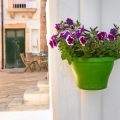Introduction to Herb Container Gardening in Britain
Herb container gardening has become an increasingly popular choice for British gardeners seeking versatility and year-round greenery, regardless of their living environment. The temperate climate of the UK, with its mild winters and moderate rainfall, offers unique opportunities and challenges for cultivating herbs in containers. Whether you live in a compact urban flat with a small balcony or a traditional countryside cottage with ample outdoor space, growing herbs in pots allows you to make the most of available sunlight and shelter your plants from adverse weather conditions. Container gardening also provides greater control over soil quality and drainage, making it ideal for beginners and experienced gardeners alike. Moreover, having fresh culinary herbs within arm’s reach adds both flavour and fragrance to everyday life, enhancing home-cooked meals while supporting a sustainable lifestyle. By understanding how to adapt herb container gardening practices to the changing British seasons, you can enjoy a thriving herb garden throughout the entire year.
2. Choosing the Right Containers and Soil for British Conditions
Successful year-round herb container gardening in Britain begins with selecting containers and soil that can withstand the country’s unpredictable weather. The right choices will protect your herbs from excessive rain, cold snaps, and summer heatwaves—ensuring a thriving herb display whatever the season.
Container Selection: Size, Material, and Style
British gardens benefit from a range of container styles, each offering different advantages in terms of durability, insulation, and sustainability. Consider these common options:
| Container Type | Advantages | Considerations for UK Climate |
|---|---|---|
| Terracotta Pots | Classic look; breathable for roots | Prone to cracking in frost; consider frost-proofed versions or move indoors over winter |
| Ceramic Pots | Decorative; good insulation | Heavy; ensure drainage holes; may need extra insulation in severe cold |
| Plastic Pots/Troughs | Lightweight; affordable; retain moisture well | Can become brittle over time; less environmentally friendly unless recycled materials are used |
| Wooden Planters (e.g. cedar or oak) | Sustainable; natural insulation; blends into traditional British gardens | Treat with eco-friendly preservatives to prevent rot; ensure robust construction for wet conditions |
| Metal Containers (e.g. galvanised steel) | Modern aesthetic; durable if rust-resistant | Can overheat in summer sun and chill quickly in winter; insulate if necessary |
| Bamboo or Coir Pots | Sustainable and biodegradable options; excellent for eco-conscious gardeners | Best suited for seasonal displays as they degrade over time; not ideal for permanent plantings or very wet climates without lining |
Compost and Soil Mixes Suited to British Weather Patterns
The variable rainfall and often cool temperatures across Britain require a potting mix that balances drainage with moisture retention. Look for peat-free multipurpose compost, which supports sustainability while providing nutrients. Mix in horticultural grit or perlite to improve drainage—especially crucial during wet spells.
| Soil Component | Purpose in British Conditions |
|---|---|
| Peat-Free Compost Base | Nutrient-rich, sustainable alternative to peat-based mixes, supporting local biodiversity goals. |
| Horticultural Grit/Sand/Perlite (10–20%) | Aids drainage to prevent root rot during periods of heavy rain. |
| Mature Garden Compost or Well-Rotted Manure (optional) | Adds organic matter and improves soil structure for robust herb growth. |
| Lime (for Mediterranean herbs like rosemary or thyme) | Raises pH for herbs preferring alkaline soils common in southern England. |
Pots: Drainage and Insulation Strategies
- Drainage Holes: Always choose containers with sufficient drainage holes to prevent waterlogging—a frequent issue during wet British winters.
- Crockery Shards/Gravel Layer: Place at the bottom of pots to enhance drainage efficiency without blocking holes.
- Pots on Feet: Elevate containers using pot feet or bricks to allow excess water to escape freely—particularly important on patios or balconies prone to pooling water.
- Insulation Tips: For year-round gardening, wrap pots with hessian or bubble wrap during frosts, group pots together for mutual shelter, or use double-walled planters for sensitive herbs.
Sustainable Choices for Eco-Conscious Gardeners
- Select recycled plastic or upcycled containers where possible to reduce environmental impact.
- Avoid peat-based composts by choosing certified peat-free alternatives widely available at UK garden centres.
- If using wooden planters, opt for FSC-certified timber treated with non-toxic preservatives.
Your Foundation for Year-Round Success
The combination of carefully chosen containers and tailored compost is foundational to successful herb container gardening across Britain’s diverse climates. With robust drainage systems, insulated pots, and sustainable material choices, your herbs will flourish through every season—from spring sowings to winter harvests.

3. Herb Selection for Every Season
Successfully cultivating a thriving herb container garden in Britain requires an understanding of which varieties perform best throughout the year. The UK’s distinct seasonal shifts mean your selection should be carefully tailored to each period, making the most of both hardy perennials and vigorous annuals. Below is a detailed seasonal breakdown, highlighting local favourites and herbs renowned for their reliability.
Spring: Awakening Flavours
As daylight lengthens and temperatures gradually rise, spring is ideal for sowing robust herbs. Chives are a British staple, bursting into life with tender green shoots that add a mild onion note to dishes. Parsley, particularly the flat-leaf variety, thrives in cooler spring conditions and can be sown early under cover. Coriander prefers the coolness of spring before summer heat causes it to bolt.
Summer: Sun-Loving Aromatics
The warmer months favour sun-loving Mediterranean herbs. Basil, though needing shelter in northern regions, flourishes in warm, bright spots. Thyme and oregano, two quintessentially British favourites with continental origins, relish well-drained containers in full sun. Dill also performs well, adding feathery texture and fresh flavour.
Autumn: Resilient Performers
As temperatures dip, shift focus to hardy herbs that tolerate cooler weather. Sage, with its velvety leaves and earthy aroma, stands up well to autumn’s chill. Mints, especially traditional varieties like spearmint, continue producing new growth until the first frosts. Chervil, often overlooked, enjoys the milder conditions of early autumn.
Winter: Evergreen Essentials
The British winter need not mean barren containers—certain stalwarts provide greenery year-round. Rosemary, revered for its resilience and aromatic foliage, endures cold snaps with minimal fuss if given shelter from biting winds. Bay laurel, another evergreen favourite, offers glossy leaves for culinary use even in the depths of winter. Thyme, once established, provides sprigs throughout the season as well.
Year-Round All-Stars
A handful of herbs offer persistent value regardless of season. Perennial chives, if cut back after flowering, regenerate swiftly and tolerate British weather admirably. Lemon balm is another versatile choice—vigorous and fragrant from spring to late autumn with some protection during harsher months.
Cultural Tips for British Growers
Selecting locally adapted cultivars ensures greater success; consult nearby nurseries for recommendations suited to your microclimate. Embrace succession planting by starting new batches every few weeks during peak seasons, ensuring a constant supply for your kitchen all year round.
4. Seasonal Planting and Maintenance Calendar
Effective container herb gardening in Britain requires a well-structured approach throughout the changing seasons. Understanding the UK’s variable climate ensures your herbs remain healthy, productive, and resilient all year round. Below is a month-by-month guide tailored to the British environment, outlining key tasks such as sowing, transplanting, pruning, and feeding.
Month-by-Month Herb Care in the UK
| Month | Sowing & Transplanting | Pruning & Maintenance | Feeding & Other Tips |
|---|---|---|---|
| January | Plan your container garden; order seeds | Remove dead foliage; check for frost damage | Avoid watering unless containers are dry indoors |
| February | Sow hardy herbs (parsley, chives) indoors | Tidy containers; prepare compost mixes | Begin gentle indoor feeding for early growth |
| March | Sow basil, coriander indoors; transplant overwintered cuttings | Pinch back leggy growth; monitor for pests | Add slow-release fertiliser to soil mix |
| April | Sow tender herbs indoors or under cover; harden off seedlings | Trim rosemary and thyme lightly | Gradually increase watering as days lengthen |
| May | Transplant established seedlings outside after last frost | Deadhead flowers to encourage leaf growth | Feed with balanced liquid fertiliser fortnightly |
| June | Sow quick-maturing herbs outdoors (dill, coriander) | Regularly harvest to promote bushiness | Monitor for aphids and water consistently in warm spells |
| July | Sow additional basil for late summer crops | Prune mint and lemon balm aggressively to prevent spreading | Add mulch to retain moisture during heatwaves |
| August | Sow chervil and parsley for autumn harvests | Tidy up containers; remove faded leaves and stems | Mist herbs on hot days to boost humidity levels |
| September | Sow hardy perennial seeds for next year (thyme, sage) | Bolt-prone herbs can be cut back and divided if needed | Lessen feeding as growth slows down with cooler nights |
| October | Bring tender herbs indoors before first frost hits | Cull any unhealthy plants; clean pots thoroughly | Avoid overwatering; check drainage regularly in wet weather |
| November | No sowing; focus on indoor care for overwintered herbs | Cull any weak stems; monitor for mould or rot indoors | Add grit to potting mix for improved winter drainage |
| December | No sowing; maintain dormant state of outdoor perennials | Tidy up fallen leaves around containers to deter slugs | Minimal watering needed; keep pots off frozen surfaces |
Top Tips for Year-Round Success
- Utilise cold frames or cloches to extend the growing season
- Choose frost-hardy varieties for outdoor winter resilience
- Group containers together in exposed months to protect roots from cold snaps
- Rotate container positions throughout the year to maximise sunlight exposure
Adapting Your Routine
British weather can be unpredictable—always check local forecasts and adapt your routine accordingly. By following this seasonal calendar, your herb containers will thrive whatever the weather, offering fresh flavours from your patio or balcony throughout the year.
5. Managing Common Pests and Weather Challenges
Understanding British Garden Threats
Year-round herb container gardening in Britain means facing a unique set of challenges, primarily dictated by the local climate and native pests. From heavy autumn rains and winter frosts to persistent slugs, snails, and aphids, British gardeners must be well-prepared with practical, eco-friendly solutions.
Weatherproofing Your Containers
Heavy Rain: To prevent waterlogged roots during frequent downpours, ensure all containers have sufficient drainage holes. Elevate pots on bricks or pot feet to encourage run-off and avoid standing water.
Frost Protection: During harsh winters, group containers together in sheltered spots or move them against south-facing walls for residual warmth. Wrapping pots with hessian or bubble wrap helps insulate roots. Hardy herbs like rosemary and thyme cope well outdoors, but tender varieties such as basil should be brought indoors or into a greenhouse.
Eco-Friendly Pest Control Strategies
Slugs and Snails
These are notorious in the UK’s damp climate. Use copper tape around pot rims to deter them naturally. Encourage natural predators such as hedgehogs and birds by keeping your garden wildlife-friendly. Beer traps—partially buried containers filled with beer—can also lure slugs away from precious herbs.
Aphids and Other Insects
Aphids thrive in mild British springs and summers. Regularly inspect herbs for infestations. Spray affected plants with a diluted solution of washing-up liquid (eco-friendly brands preferred) or use neem oil as an organic deterrent. Companion planting with strong-scented herbs like chives or mint can confuse pests and reduce their numbers naturally.
Cultural Practices for Healthy Herbs
Rotate container positions periodically to disrupt pest life cycles. Remove any yellowing leaves or plant debris promptly to reduce hiding spots for insects and fungal spores. Water early in the day to allow foliage to dry before evening, minimising the risk of mildew—a common problem in humid British conditions.
Local Solutions and Community Resources
Join local gardening groups or allotment societies for advice tailored to your area’s microclimate. Many communities organise seed swaps for pest-resistant herb varieties adapted to British weather. By sharing experiences and solutions, you’ll create a more resilient, thriving herb garden throughout the year.
6. Harvesting, Using, and Overwintering Your Herbs
Best Practices for Harvesting Herbs at Their Peak
The optimal time to harvest most herbs is just before they flower, when their essential oils are at their highest concentration. For leafy herbs such as basil, mint, and parsley, use sharp scissors or secateurs to snip off the upper stems in the morning after any dew has dried. This encourages bushier growth and a continual supply. Woody herbs like rosemary and thyme benefit from regular tip pruning but avoid cutting into old wood. Always leave enough foliage on the plant to maintain health and vigour.
Creative Culinary and Home Uses Rooted in British Tradition
Herbs have been an integral part of British cuisine and home remedies for centuries. Freshly picked chives and parsley elevate classic dishes such as new potato salad or roast lamb, while mint transforms simple peas into a traditional accompaniment. For drinks, infuse lemon balm or borage leaves in summer cordials or Pimm’s. Beyond the kitchen, lavender sachets freshen linen cupboards and bay leaves are commonly used in potpourri or winter stews. Try creating your own herbal teas or flavoured vinegars—both cherished British traditions that make excellent homemade gifts.
Overwintering: Keeping Your Herb Garden Productive Through Winter
With Britain’s variable winters, overwintering strategies are crucial for year-round container gardening success. Move tender herbs such as basil and coriander indoors onto sunny windowsills as temperatures drop. Hardy perennials like rosemary, thyme, and sage can stay outside but benefit from sheltered spots near house walls and raised pots to improve drainage. Mulch containers with straw or horticultural fleece to insulate roots during frosts. Regularly check for waterlogged compost—herbs dislike soggy conditions even in winter. By integrating these practices, you’ll ensure a continuous supply of homegrown herbs through all seasons.


